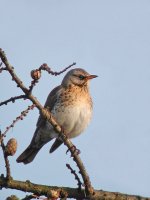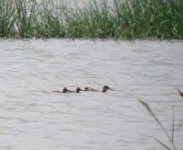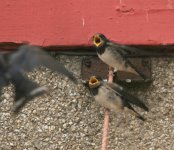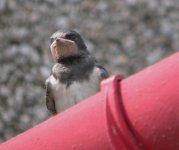-
Welcome to BirdForum, the internet's largest birding community with thousands of members from all over the world. The forums are dedicated to wild birds, birding, binoculars and equipment and all that goes with it.
Please register for an account to take part in the discussions in the forum, post your pictures in the gallery and more.
You are using an out of date browser. It may not display this or other websites correctly.
You should upgrade or use an alternative browser.
You should upgrade or use an alternative browser.
Why Digiscope? (1 Viewer)
- Thread starter John151
- Start date
More options
Who Replied?robinm
Registered User
For me the decision to digiscope is simple. I already carry a scope when out birding, therefore it is relatively easy to carry the additional kit required to digiscope (camera, adaptor etc.). To use a camera and long lens (ignoring the expense of purchasing the kit) would require me to carry a lot of heavy kit or not, say, take my scope.
The SLR/long lens combination will produce better photos but for someone like me is simply not a practical choice.
The SLR/long lens combination will produce better photos but for someone like me is simply not a practical choice.
Ruby
Well-known member
Hi John,
I'm sure that there are many differences, but amongst the key ones are :-
Even a long lens like a 400mm will only allow decent-sized images of birds at comparitively close range - the optical power of a telescope, coupled with camera magnification, allows images to be taken at far greater distances.
... but, the image quality is usually much better with a camera.
Assuming you already have a telescope for birdwatching, digiscoping is likely to be a cheaper option.
May be shot down in flames here, but in my experience, the problems of framing your subject, getting exposure and focus right, and then taking the shot is much easier with just a camera.....
My own feeling is that most digiscopers are just birdwatchers with telescopes who enjoy the added option of being able to take record schots of the birds that they see, and are delighted when they get a halfway decent image.
With camera buffs, the photography/image is the priority....
Hope that helps..... Ruby
I'm sure that there are many differences, but amongst the key ones are :-
Even a long lens like a 400mm will only allow decent-sized images of birds at comparitively close range - the optical power of a telescope, coupled with camera magnification, allows images to be taken at far greater distances.
... but, the image quality is usually much better with a camera.
Assuming you already have a telescope for birdwatching, digiscoping is likely to be a cheaper option.
May be shot down in flames here, but in my experience, the problems of framing your subject, getting exposure and focus right, and then taking the shot is much easier with just a camera.....
My own feeling is that most digiscopers are just birdwatchers with telescopes who enjoy the added option of being able to take record schots of the birds that they see, and are delighted when they get a halfway decent image.
With camera buffs, the photography/image is the priority....
Hope that helps..... Ruby

Hi John,
Massive magnification (3,000mm or more) and pocket-sized camera are the two major benefits. Cost is debatable these days, as dslr prices have come down to what many paid for the Nikon coolpix cameras a few years ago... but there's no getting away from the price of a lens of a sensible focal length.
Digiscoping is very much a birder's method... already weighed down with scope/tripod and binos, a dslr+lens is just a bit too much for most. As the birder will already own a scope/tripod, a fairly cheap pocket sized digital camera is all that is basically needed.
The huge magnification allows far greater stand-off capabilities (i.e. not disturbing the subject), a thrush sized bird can be digiscoped at 40 yards... though best results are always when as close as possible.
cheers,
Andy
Massive magnification (3,000mm or more) and pocket-sized camera are the two major benefits. Cost is debatable these days, as dslr prices have come down to what many paid for the Nikon coolpix cameras a few years ago... but there's no getting away from the price of a lens of a sensible focal length.
Digiscoping is very much a birder's method... already weighed down with scope/tripod and binos, a dslr+lens is just a bit too much for most. As the birder will already own a scope/tripod, a fairly cheap pocket sized digital camera is all that is basically needed.
The huge magnification allows far greater stand-off capabilities (i.e. not disturbing the subject), a thrush sized bird can be digiscoped at 40 yards... though best results are always when as close as possible.
cheers,
Andy
For me the biggest advantages of digiscoping are:
1. higher magnification than with slr & long lens - can take pics of birds taht are further away
2. smallaer lighter cameras - if your already carrying a scope a digiscoping camera can easily fit in a pocket. My digiscoping camera weighs less than 250g (inc spare battery and card), my dslr and lenses comes in at over 4.5kg.
3. cheaper to start (if you already have a scope) - digiscoping cameras will set you back about £2-300, cheapest dslr with 400mm lens would be ~£800.
Advantages of dSLR are:
1. faster camera set up - means I'm more likely to get the shot.
2. taking birds in flight is possible - I've never got to grips with it digiscoping (though others seem able to).
3. in general the image quality is far better - I keep a higher percentage of photos.
1. higher magnification than with slr & long lens - can take pics of birds taht are further away
2. smallaer lighter cameras - if your already carrying a scope a digiscoping camera can easily fit in a pocket. My digiscoping camera weighs less than 250g (inc spare battery and card), my dslr and lenses comes in at over 4.5kg.
3. cheaper to start (if you already have a scope) - digiscoping cameras will set you back about £2-300, cheapest dslr with 400mm lens would be ~£800.
Advantages of dSLR are:
1. faster camera set up - means I'm more likely to get the shot.
2. taking birds in flight is possible - I've never got to grips with it digiscoping (though others seem able to).
3. in general the image quality is far better - I keep a higher percentage of photos.

I forgot to sing the praises of dslr+long lens, and there's plenty to sing about! But to give you an idea of the magnification available to the digiscoper, the attached photo is of a Fieldfare at 45 yards (measured) and this is the full uncropped shot (just downsized for the web).
Attachments
Robert L Jarvis
Robert L Jarvis
Andy's shot says it all, with a camera you would have to be so close the bird would have flown!!! With a 400mm len all you get is 8x mag which is just too little unless your bird is big, big ,big. But there is the question of connecting a dslr to a scope which has been plaguing many people as to how to manage that, some have done so. But the connections/adapters are not yet really thought out.
Robert Jarvis
Robert Jarvis
IanF
Moderator
Um! Please, please, please tell me where?postcardcv said:..............
3. cheaper to start (if you already have a scope) - digiscoping cameras will set you back about £2-300, cheapest dslr with 400mm lens would be ~£800.
..................
Best prices I've found so far are roughly £800 x2 !!!
I agree with everything mentioned above regards digiscoping v DSLR. Mind you to get photos of the quality Andy manages you do need to be well practices and be using top of the range equipment which if starting off will mean paying the same prices as a new DSLR plus longish (400mm) lens.
For me it's down balancing quality v convenience. No doubt about it DSLR's properly used will produce far superior quality photos to digiscoping. Hoever I'd be hard pressed to go birdwatching carrying a DSLR - really I think you'd need to be doing specific photographic minded trips and spending a good deal of time trying to get a lot closer to the birds using hides and fieldcraft.
Digiscoping whilst inferior in quality is more convenient to do as yuo don't have to try to creep up on the birds as much. Even at 30-40 yards though many species can find that a bit too close for comfort.
Also it also boils down to end result as to what you want to use the photos for. If printing to A4 or above then really a DSLR may be better. If the photos are for web use or smaller prints then digiscoping may well suffice.
IanF said:Um! Please, please, please tell me where?
Best prices I've found so far are roughly £800 x2 !!!
Oh dear - I see how that reads now - I was meaning a dslr and zoom (400mm at top end) rather than a 400mm prime.
You could get a Canon EOS350D for £529 (or Nikon D50 for £475) and a Sigma 135-400mm zoom for £299, so the whole thing would be about £800. Probably the best (cheap but still excellent quality) set up for a 400mm prime would be an EOS 350D (£529) and Canon 400m f5.6L (£769) giving you a great set up for ~£1300... sorry if I built your hopes up (o)<
IanF said:I'd be hard pressed to go birdwatching carrying a DSLR - really I think you'd need to be doing specific photographic minded trips and spending a good deal of time trying to get a lot closer to the birds using hides and fieldcraft.
If you use a decent camera bag (like a Lowepro rucksac) it is suprisingly easy to carry some fairly weighty camera kit round all day.
Digiscoping and dslr's provide very different opportunities, which is why having finally taken the plunge and got a dslr I still carry my digiscoping camera with me. The digiscoping camera will often take more photos in a days birding, but I still seem to get more keepers from the dslr.
Last edited:

Ah, to be young and fit again.... actually I was never fitpostcardcv said:If you use a decent camera bag (like a Lowepro rucksac) it is suprisingly easy to carry some fairly weighty camera kit round all day.
Digiscoping and dslr's provide very different opportunities, which is why having finally taken the plunge and got a dslr I still carry my digiscoping camera with me.
christineredgate
Winner of the Copeland Wildlife Photographer of th
I still prefer digiscoping ,there is no comparison to the magnification of a digiscoped image.I have tried an 800mm prime lens,a mistake,could hardly haul it onto the tripod,I did actually take it to the hide to take a shot of the Grebe on its nest.But the image taken with 4500 and scope was much clearer.I have also tried a 500mm lens,took it to photo the Herons in the trees.Not bad,but no comparison with the digiscope images.If I have to use a tripod might just as well use a lightweight scope and a small camera.It is just a shame that many of the digiscoped images are not as clear as those taken with a prime lens,but that is due to my lack of expertise,not the equipment.One only has to see Andy B's shots,or those of say Paul Hackett,absolutely superb,or even Digiscoper's images,he posts on the Gallery.
Just for fun I though that I would throw in the fact that you could always use a prime lens for a scope too. The optics of the Nikon 300mm f4 lens are recessed deep into the lens and a scope eyepiece fits nicely in there. With the right adapter you could very easily switch between viewing and photographing with the DSLR. Particularly useful when you have to trek kms to a hide for an all day stint and have to take 2 litres of water with you as well.
The main reason that DSLRs quality has been better has been a factor of resolution and distance. The resolution of digicams is now getting up there with DSLRs and of course you have no mirror slap. The further away the subject the less detail the camera will see (heat haze plays a big part here, particularly over water ). If you photograph the same subject with both tecknologies at the same distance (assuming top quality glass for both) you would be hard pressed to see the difference these days. And how good will Panasonics new 8meg Lumix, 12x ,2,8fixed, Image Stabilised Leica lens be? For flight shots or fast, close action you can't beat the DSLR and a fast prime lens though.
For satisfaction for me you can't beat a digiscoped image at 70 meters that most others can hardily see with their bins. The attached photo of the swimming family of Painted Snipe (this was at 90 meters) is the reason I don't go anywhere without my digiscoping gear. It will never win any awards that's for sure but it made me happier than most images I've taken (my Spoon-Billed Sandpiper at 120 meters and 60x mag on the scope in my gallery made me the happiest I've been for a long time - photography wise). Just my thoughts, Neil.
The main reason that DSLRs quality has been better has been a factor of resolution and distance. The resolution of digicams is now getting up there with DSLRs and of course you have no mirror slap. The further away the subject the less detail the camera will see (heat haze plays a big part here, particularly over water ). If you photograph the same subject with both tecknologies at the same distance (assuming top quality glass for both) you would be hard pressed to see the difference these days. And how good will Panasonics new 8meg Lumix, 12x ,2,8fixed, Image Stabilised Leica lens be? For flight shots or fast, close action you can't beat the DSLR and a fast prime lens though.
For satisfaction for me you can't beat a digiscoped image at 70 meters that most others can hardily see with their bins. The attached photo of the swimming family of Painted Snipe (this was at 90 meters) is the reason I don't go anywhere without my digiscoping gear. It will never win any awards that's for sure but it made me happier than most images I've taken (my Spoon-Billed Sandpiper at 120 meters and 60x mag on the scope in my gallery made me the happiest I've been for a long time - photography wise). Just my thoughts, Neil.
Attachments
John151 said:Thank you Neil, now you have really got me thinking. I already have a 100/400mm IS lens for my 20D. Can I get an eye piece to fit this?
John
John,
It would be a little different with the zoom I imagine as the rear element is probably flush with the mount (it is on my Nikon 80-400 zoom anyway ). You can test it by hand holding a scope/telescope eyepiece to the rear element and looking through. If you already have a digital camera and eyepiece and adapter then you can handhold it to the lens. I have tried it with my 300mm, my Nikon 105mm Macro and a 500/f8 mirror lens. Quality-wise a prime lens would be the way to go and probably a second hand one would be good enough. A simple adapter could be made from a Canon lens cap and a few bits and pieces. I haven't done this but there are plenty of people who have out there. I just used some masking tape around the eyepiece and it zapped right into the Nikon 300mm/f4 so that it was easy to do some tests. Of course you can also photograph using a DSLR this way to. Use a 50mm prime lens on the DSLR and you can turn the lens plus eyepiece into a super-telephoto lens. There has been discussions elsewhere in this Forum on the pros and cons of doing this. If you go the telescope route , rather than the spotting scope route then you have many more options. For the eyepiece you just need a good quality, 25mm Plossl with about 20mm of eye relief. Your local telescope shop has them or you can buy them over the internet (Televue is a good place to start ). The connection of all these items together is the difficult part and will depend on the lens , the camera and the eyepiece that you use. Do some more research first to be sure what you want to do.
I hope this hasn't confused you further, Neil.
Jay Turberville
Well-known member
IanF said:For me it's down balancing quality v convenience. No doubt about it DSLR's properly used will produce far superior quality photos to digiscoping. Hoever I'd be hard pressed to go birdwatching carrying a DSLR - really I think you'd need to be doing specific photographic minded trips and spending a good deal of time trying to get a lot closer to the birds using hides and fieldcraft.
Digiscoping whilst inferior in quality is more convenient to do as yuo don't have to try to creep up on the birds as much. Even at 30-40 yards though many species can find that a bit too close for comfort.
If you are going to carry the scope with you anyway, then digiscoping is a pretty easy choice. If not, then the question comes down to how much magnification you need/want (or how close it is that you can get to your subject).
A DSLR with a very good or excellent lens (expensive) will typically outperform a very good or excellent digiscoping rig. But the difference in quality is not nearly as great as some are suggesting when variables are normalized. For instance, I saw a recent comparision between a Canon DSLR with a top end long lens and matching teleconverter (I think 1.4x) and a CP5000 at a similar equivalent focal length (around 1200mm as I recall) and the DSLR shot was not nearly as sharp as you might expect. The additional magnification and camera to subject difference eats into the advantage that the superior optics should have. The crystal sharp bird images that we see taken with DSLRs are often taken at very close distances. It is not only a matter of camera and optics, but also overall magnification and the effects of the air between camera and subject. Once you start shooting at 1000mm equivalents or better and the resulting longer distances, the DSLR advantages begin to diminish fairly rapidly.
So it boils down to "horses for courses". If the subject can be adequately reached with a 400mm lens and a teleconverter, then the DSLR is your best bet. But if not, you want to seriously look at a digiscoping rig - or a very expensive special purpose lens.
John151
John
Thank you Jay. Typically I can get within 12 m of the birds I shoot ( sorry photograph) and that seems to be the limit for good quality with my 400 mm IS lens hand held. I am going to Tichwell soon and I don't think the birds are going to be within 12 m and that is why I am thinking about digi-scoping. All good wishes, John
Jay Turberville
Well-known member
John151 said:Thank you Jay. Typically I can get within 12 m of the birds I shoot ( sorry photograph) and that seems to be the limit for good quality with my 400 mm IS lens hand held. I am going to Tichwell soon and I don't think the birds are going to be within 12 m and that is why I am thinking about digi-scoping. All good wishes, John
If you go with some digiscoping gear, get it and practice before going. The greater focal length equivalence of digiscoping means you must take extra care with vibration etc. "Shooting" at 2000mm vs. 600mm equivalences is a big difference. You will want to get some idea of the gear's limitations. The extra reach is nice, but there are practical limits imposed by air turbulence and clarity.
I've been very impressed with the Olympus C7070's image quality and it has barely acceptable RAW write times (6-7 secs). It likes an eyepiece with a bit more than 20mm of eye relief and a wide view for more zoom range, but the typical 19-20mm eyepieces will work - though with a bit less zoom range than you might get with a CP4500.
christineredgate
Winner of the Copeland Wildlife Photographer of th
A couple of images taken today,the first image of the 2 Swallows with their mouths open as Mum passes by at the side,this was taken with a 100-400 lens and 1x4 converter,not a good image,they were in a darkish corner under the window sill,and the second image,the young Swallow peeping over the guttering waiting for his turn to be fed,this image was digiscoped.They were taken from excactly the same distance away.In fact the for the 1st image I was fractionally nearer,trying to balance the cam on a wall.Hopefully this should show the greater magnification using the cam plus scope.
Attachments
Users who are viewing this thread
Total: 2 (members: 0, guests: 2)







